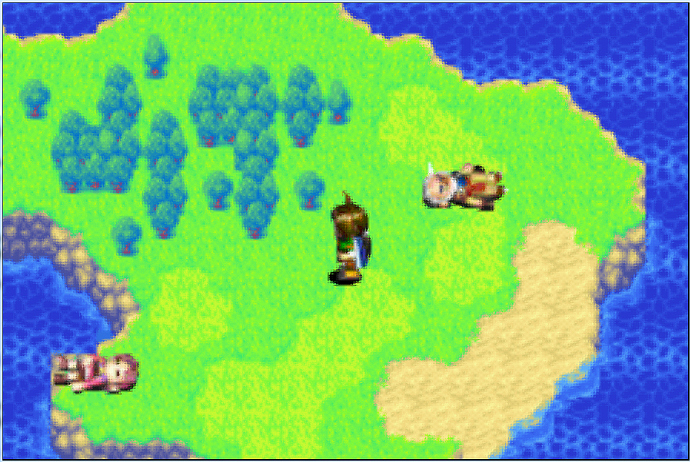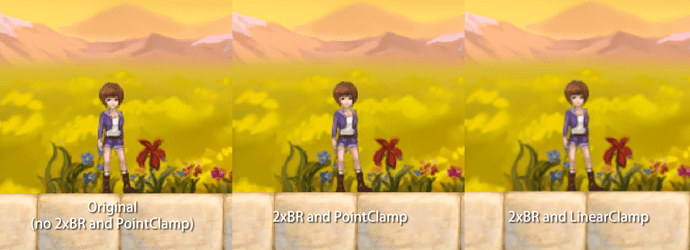I’ve been trying to make xBR shader work in MG for a while and just got it done. Here is the code:
=Effect file=
This shader was originally written by Hyllian and I translated it from GLSL to HLSL.
Note: You can try out those different value sets for those four parameters.
//XBR_SCALE "xBR Scale" 4.0 1.0 5.0 1.0
//XBR_Y_WEIGHT "Y Weight" 48.0 0.0 100.0 1.0
//XBR_EQ_THRESHOLD "Eq Threshold" 25.0 0.0 50.0 1.0
//XBR_LV2_COEFFICIENT "Lv2 Coefficient" 2.0 1.0 3.0 0.1
float XBR_SCALE = 4.0;
float XBR_Y_WEIGHT = 48.0;
float XBR_EQ_THRESHOLD = 25.0;
float XBR_LV2_COEFFICIENT = 2.0;
float2 textureSize;
float4x4 matrixTransform;
sampler decal : register(s0);
// END PARAMETERS //
// Uncomment just one of the three params below to choose the corner detection
#define CORNER_A
//#define CORNER_B
//#define CORNER_C
//#define CORNER_D
const static float4 Ao = float4( 1.0, -1.0, -1.0, 1.0 );
const static float4 Bo = float4( 1.0, 1.0, -1.0,-1.0 );
const static float4 Co = float4( 1.5, 0.5, -0.5, 0.5 );
const static float4 Ax = float4( 1.0, -1.0, -1.0, 1.0 );
const static float4 Bx = float4( 0.5, 2.0, -0.5,-2.0 );
const static float4 Cx = float4( 1.0, 1.0, -0.5, 0.0 );
const static float4 Ay = float4( 1.0, -1.0, -1.0, 1.0 );
const static float4 By = float4( 2.0, 0.5, -2.0,-0.5 );
const static float4 Cy = float4( 2.0, 0.0, -1.0, 0.5 );
const static float4 Ci = float4(0.25, 0.25, 0.25, 0.25);
const static float3 Y = float3(0.2126, 0.7152, 0.0722);
float4 df(float4 A, float4 B)
{
return float4(abs(A-B));
}
float c_df(float3 c1, float3 c2)
{
float3 df = abs(c1 - c2);
return df.r + df.g + df.b;
}
bool4 eq(float4 A, float4 B)
{
return (df(A, B) < float4(XBR_EQ_THRESHOLD,XBR_EQ_THRESHOLD,XBR_EQ_THRESHOLD,XBR_EQ_THRESHOLD));
}
float4 weighted_distance(float4 a, float4 b, float4 c, float4 d, float4 e, float4 f, float4 g, float4 h)
{
return (df(a,b) + df(a,c) + df(d,e) + df(d,f) + 4.0*df(g,h));
}
struct out_vertex {
float4 position : POSITION;
float4 color : COLOR;
float2 texCoord : TEXCOORD0;
float4 t1 : TEXCOORD1;
float4 t2 : TEXCOORD2;
float4 t3 : TEXCOORD3;
float4 t4 : TEXCOORD4;
float4 t5 : TEXCOORD5;
float4 t6 : TEXCOORD6;
float4 t7 : TEXCOORD7;
};
/* VERTEX_SHADER */
out_vertex main_vertex
(
float4 position : POSITION,
float4 color : COLOR,
float2 texCoord : TEXCOORD0
)
{
out_vertex OUT;
OUT.position = mul(position, matrixTransform);
OUT.color = color;
float2 ps = float2(1.0/textureSize.x, 1.0/textureSize.y);
float dx = ps.x;
float dy = ps.y;
// A1 B1 C1
// A0 A B C C4
// D0 D E F F4
// G0 G H I I4
// G5 H5 I5
OUT.texCoord = texCoord;
OUT.t1 = texCoord.xxxy + float4( -dx, 0, dx,-2.0*dy); // A1 B1 C1
OUT.t2 = texCoord.xxxy + float4( -dx, 0, dx, -dy); // A B C
OUT.t3 = texCoord.xxxy + float4( -dx, 0, dx, 0); // D E F
OUT.t4 = texCoord.xxxy + float4( -dx, 0, dx, dy); // G H I
OUT.t5 = texCoord.xxxy + float4( -dx, 0, dx, 2.0*dy); // G5 H5 I5
OUT.t6 = texCoord.xyyy + float4(-2.0*dx,-dy, 0, dy); // A0 D0 G0
OUT.t7 = texCoord.xyyy + float4( 2.0*dx,-dy, 0, dy); // C4 F4 I4
return OUT;
}
/* FRAGMENT SHADER */
float4 main_fragment(in out_vertex VAR) : COLOR0
{
bool4 edri, edr, edr_left, edr_up, px; // px = pixel, edr = edge detection rule
bool4 interp_restriction_lv0, interp_restriction_lv1, interp_restriction_lv2_left, interp_restriction_lv2_up;
float4 fx, fx_left, fx_up; // inequations of straight lines.
float4 delta = float4(1.0/XBR_SCALE, 1.0/XBR_SCALE, 1.0/XBR_SCALE, 1.0/XBR_SCALE);
float4 deltaL = float4(0.5/XBR_SCALE, 1.0/XBR_SCALE, 0.5/XBR_SCALE, 1.0/XBR_SCALE);
float4 deltaU = deltaL.yxwz;
float2 fp = frac(VAR.texCoord*textureSize);
float3 A1 = tex2D(decal, VAR.t1.xw).rgb;
float3 B1 = tex2D(decal, VAR.t1.yw).rgb;
float3 C1 = tex2D(decal, VAR.t1.zw).rgb;
float3 A = tex2D(decal, VAR.t2.xw).rgb;
float3 B = tex2D(decal, VAR.t2.yw).rgb;
float3 C = tex2D(decal, VAR.t2.zw).rgb;
float3 D = tex2D(decal, VAR.t3.xw).rgb;
float3 E = tex2D(decal, VAR.t3.yw).rgb;
float3 F = tex2D(decal, VAR.t3.zw).rgb;
float3 G = tex2D(decal, VAR.t4.xw).rgb;
float3 H = tex2D(decal, VAR.t4.yw).rgb;
float3 I = tex2D(decal, VAR.t4.zw).rgb;
float3 G5 = tex2D(decal, VAR.t5.xw).rgb;
float3 H5 = tex2D(decal, VAR.t5.yw).rgb;
float3 I5 = tex2D(decal, VAR.t5.zw).rgb;
float3 A0 = tex2D(decal, VAR.t6.xy).rgb;
float3 D0 = tex2D(decal, VAR.t6.xz).rgb;
float3 G0 = tex2D(decal, VAR.t6.xw).rgb;
float3 C4 = tex2D(decal, VAR.t7.xy).rgb;
float3 F4 = tex2D(decal, VAR.t7.xz).rgb;
float3 I4 = tex2D(decal, VAR.t7.xw).rgb;
float4 b = mul( float4x3(B, D, H, F), XBR_Y_WEIGHT*Y );
float4 c = mul( float4x3(C, A, G, I), XBR_Y_WEIGHT*Y );
float4 e = mul( float4x3(E, E, E, E), XBR_Y_WEIGHT*Y );
float4 d = b.yzwx;
float4 f = b.wxyz;
float4 g = c.zwxy;
float4 h = b.zwxy;
float4 i = c.wxyz;
float4 i4 = mul( float4x3(I4, C1, A0, G5), XBR_Y_WEIGHT*Y );
float4 i5 = mul( float4x3(I5, C4, A1, G0), XBR_Y_WEIGHT*Y );
float4 h5 = mul( float4x3(H5, F4, B1, D0), XBR_Y_WEIGHT*Y );
float4 f4 = h5.yzwx;
// These inequations define the line below which interpolation occurs.
fx = (Ao*fp.y+Bo*fp.x);
fx_left = (Ax*fp.y+Bx*fp.x);
fx_up = (Ay*fp.y+By*fp.x);
interp_restriction_lv1 = interp_restriction_lv0 = ((e!=f) && (e!=h));
#ifdef CORNER_B
interp_restriction_lv1 = (interp_restriction_lv0 && ( !eq(f,b) && !eq(h,d) || eq(e,i) && !eq(f,i4) && !eq(h,i5) || eq(e,g) || eq(e,c) ) );
#endif
#ifdef CORNER_D
float4 c1 = i4.yzwx;
float4 g0 = i5.wxyz;
interp_restriction_lv1 = (interp_restriction_lv0 && ( !eq(f,b) && !eq(h,d) || eq(e,i) && !eq(f,i4) && !eq(h,i5) || eq(e,g) || eq(e,c) ) && (f!=f4 && f!=i || h!=h5 && h!=i || h!=g || f!=c || eq(b,c1) && eq(d,g0)));
#endif
#ifdef CORNER_C
interp_restriction_lv1 = (interp_restriction_lv0 && ( !eq(f,b) && !eq(f,c) || !eq(h,d) && !eq(h,g) || eq(e,i) && (!eq(f,f4) && !eq(f,i4) || !eq(h,h5) && !eq(h,i5)) || eq(e,g) || eq(e,c)) );
#endif
interp_restriction_lv2_left = ((e!=g) && (d!=g));
interp_restriction_lv2_up = ((e!=c) && (b!=c));
float4 fx45i = saturate((fx + delta -Co - Ci)/(2*delta ));
float4 fx45 = saturate((fx + delta -Co )/(2*delta ));
float4 fx30 = saturate((fx_left + deltaL -Cx )/(2*deltaL));
float4 fx60 = saturate((fx_up + deltaU -Cy )/(2*deltaU));
float4 wd1 = weighted_distance( e, c, g, i, h5, f4, h, f);
float4 wd2 = weighted_distance( h, d, i5, f, i4, b, e, i);
edri = (wd1 <= wd2) && interp_restriction_lv0;
edr = (wd1 < wd2) && interp_restriction_lv1;
#ifdef CORNER_A
edr = edr && (!edri.yzwx || !edri.wxyz);
edr_left = ((XBR_LV2_COEFFICIENT*df(f,g)) <= df(h,c)) && interp_restriction_lv2_left && edr && (!edri.yzwx && eq(e,c));
edr_up = (df(f,g) >= (XBR_LV2_COEFFICIENT*df(h,c))) && interp_restriction_lv2_up && edr && (!edri.wxyz && eq(e,g));
#endif
#ifndef CORNER_A
edr_left = ((XBR_LV2_COEFFICIENT*df(f,g)) <= df(h,c)) && interp_restriction_lv2_left && edr;
edr_up = (df(f,g) >= (XBR_LV2_COEFFICIENT*df(h,c))) && interp_restriction_lv2_up && edr;
#endif
fx45 = edr*fx45;
fx30 = edr_left*fx30;
fx60 = edr_up*fx60;
fx45i = edri*fx45i;
px = (df(e,f) <= df(e,h));
float4 maximos = max(max(fx30, fx60), max(fx45, fx45i));
float3 res1 = E;
res1 = lerp(res1, lerp(H, F, px.x), maximos.x);
res1 = lerp(res1, lerp(B, D, px.z), maximos.z);
float3 res2 = E;
res2 = lerp(res2, lerp(F, B, px.y), maximos.y);
res2 = lerp(res2, lerp(D, H, px.w), maximos.w);
float3 res = lerp(res1, res2, step(c_df(E, res1), c_df(E, res2)));
return float4(res, 1.0);
}
technique T0
{
pass P0
{
VertexShader = compile vs_4_1 main_vertex();
PixelShader = compile ps_4_1 main_fragment();
}
}
=How to use it=
Follow this example from this link. Basically just load the effect file, pass the texture size and game window size to it and call it in Draw().
using Microsoft.Xna.Framework;
using Microsoft.Xna.Framework.Graphics;
namespace xbr
{
/// <summary>
/// This is the main type for your game
/// </summary>
public class Game1 : Microsoft.Xna.Framework.Game
{
GraphicsDeviceManager graphics;
SpriteBatch spriteBatch;
RenderTarget2D renderTarget;
Effect xbrEffect;
Matrix projection;
Matrix halfPixelOffset = Matrix.CreateTranslation(-0.5f, -0.5f, 0);
Texture2D pretend240x160Scene;
// the bounds of your 1:1 scene
Rectangle renderBounds = new Rectangle(0, 0, 240, 160);
// the bounds of your output scene (same w:h ratio)
Rectangle outputBounds = new Rectangle(0, 0, 720, 480);
public Game1()
{
base.Content.RootDirectory = "Content";
this.graphics = new GraphicsDeviceManager(this);
this.graphics.PreferredBackBufferWidth = outputBounds.Width;
this.graphics.PreferredBackBufferHeight = outputBounds.Height;
}
/// <summary>
/// Allows the game to perform any initialization it needs to before starting to run.
/// This is where it can query for any required services and load any non-graphic
/// related content. Calling base.Initialize will enumerate through any components
/// and initialize them as well.
/// </summary>
protected override void Initialize()
{
// TODO: Add your initialization logic here
base.Initialize();
}
/// <summary>
/// LoadContent will be called once per game and is the place to load
/// all of your content.
/// </summary>
protected override void LoadContent()
{
// Create a new SpriteBatch, which can be used to draw textures.
this.spriteBatch = new SpriteBatch(base.GraphicsDevice);
this.xbrEffect = Content.Load<Effect>("xbr");
// a fake scene that is a 240x160 image
this.pretend240x160Scene = base.Content.Load<Texture2D>("240x160Scene");
this.renderTarget = new RenderTarget2D(base.GraphicsDevice, this.renderBounds.Width, this.renderBounds.Height);
// default vertex matrix for the vertex method
this.projection = Matrix.CreateOrthographicOffCenter(0, this.outputBounds.Width, this.outputBounds.Height, 0, 0, 1);
// set the values of this effect, should only have to do this once
this.xbrEffect.Parameters["matrixTransform"].SetValue(halfPixelOffset * projection);
this.xbrEffect.Parameters["textureSize"].SetValue(new Vector2 { renderBounds.Width, renderBounds.Height });
}
/// <summary>
/// UnloadContent will be called once per game and is the place to unload
/// all content.
/// </summary>
protected override void UnloadContent()
{
}
/// <summary>
/// Allows the game to run logic such as updating the world,
/// checking for collisions, gathering input, and playing audio.
/// </summary>
/// <param name="gameTime">Provides a snapshot of timing values.</param>
protected override void Update(GameTime gameTime)
{
base.Update(gameTime);
}
/// <summary>
/// This is called when the game should draw itself.
/// </summary>
/// <param name="gameTime">Provides a snapshot of timing values.</param>
protected override void Draw(GameTime gameTime)
{
base.GraphicsDevice.Clear(Color.CornflowerBlue);
base.GraphicsDevice.SetRenderTarget(this.renderTarget);
// draw your scene here scaled 1:1. for now I'll just draw
// my fake 240x160 texture
spriteBatch.Begin(SpriteSortMode.Deferred, BlendState.NonPremultiplied,
SamplerState.PointClamp, null, null);
spriteBatch.Draw(this.pretend240x160Scene, this.renderBounds, this.renderBounds, Color.White);
spriteBatch.End();
// now we'll draw to the back buffer
base.GraphicsDevice.SetRenderTarget(null);
// this renders the effect
spriteBatch.Begin(SpriteSortMode.Immediate, BlendState.NonPremultiplied,
SamplerState.PointClamp, null, null, this.xbrEffect);
spriteBatch.Draw(this.renderTarget, this.outputBounds, this.renderBounds, Color.White);
spriteBatch.End();
base.Draw(gameTime);
}
}
}
Hope this helps!






